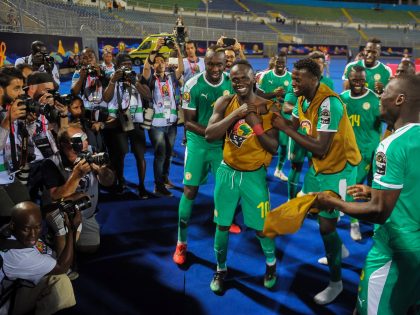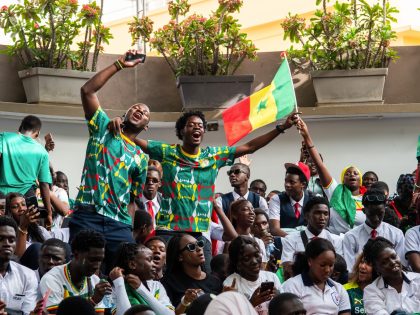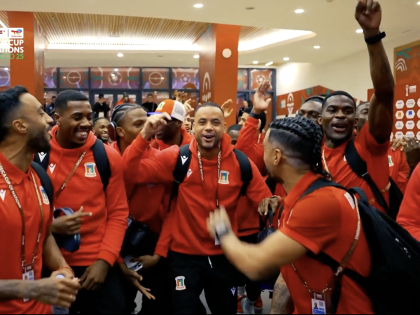Angolan football fans are no fools
Angola's Palancas Negras and the curse of the African Cup of Nations quarterfinals.

Angola's national team in action in an undated photo.
Angola has never made it past the quarterfinals at the African Cup of Nations (AFCON). The 2013 edition of the competition in South Africa marks the seventh time the Palancas Negras have been to the AFCON. Coincidentally, it was also in South Africa where the Angolans debuted in the competition, back in 1996. Although they put in some brave performances, the Palancas were marginally outclassed by the better organized Egyptians, losing 2-1 in the opening match, before losing again to hosts South Africa by 1-0 in their next fixture. For their last group game against a Cameroonian side that included 19 year-old Rigobert Song, the Palancas were winning 3-1 with eight minutes to spare after goals by Joni, Paulão and 21 year-old Quinzinho. Cameroon came back and tied the match in the 90th minute through an own goal by Helder Vicente.
Since then, Angola had decidedly mixed fortunes in the African Nations Cup. Following their debut they had another brief appearance in Burkina Faso 1998, again being paired with South Africa and again failing to reach the quarterfinals. The Palancas would not make it to the cup again until 8 years later.
Then came the heady days of October 2005 and Akwá’s goal against Rwanda that took the country to its first ever World Cup appearance (you can hear the original Angolan radio broadcast of that moment here). Sadly the Palancas were again eliminated in the first round of Afcon 2006 in Egypt, but Ghana 2008 saw their fortunes change. Manucho Gonçalves burst into the fore and helped Angola to an emphatic win against Senegal. A spirited tie against eternal rivals South Africa and a dour 0-0 draw against Tunisia saw Angola make it to the quarterfinals, where they were then promptly eliminated by Egypt. The Pharaohs went on to win the Championship.
In 2010 Angola hosted Afcon; I was in the brand new Estádio 11 de Novembro to watch their opening match nightmare against Mali, where, leading 4-0 in the 74th minute, the Palancas allowed Les Aigles to score 4 goals in about 18 minutes to tie the game (here’s a link to video of the opening ceremony and the goals). They then beat Malawi 2-0 and played to a goalless drew with Tunisia. They made it to the quarterfinals again, only to fall to eventual silver medalists Ghana. 2012 saw perhaps one of the most abject performances by our boys and despite fielding a relatively experienced side they were unable to progress from a group featuring Burkina Faso, shock quarterfinalists Sudan and the mighty Les Elephants of Côte d’Ivoire.
So it’s with those performances in mind that Angola began their preparations for the 2013 Afcon, after barely squeaking by Zimbabwe during qualifiers. They sacked former national team player Lito Vidigal after he lost 2-0 against The Warriors and appointed Gustavo Ferrín, a Uruguay virtually unknown outside of South America and certainly a complete stranger in Luanda. Growing murmurs of discontent were heard among the Palancas faithful and many feared another AFCON absence, especially since Angola had also failed to make it to World Cup 2010 right next door.
But alas, that man Manucho struck two in quick succession after a corner and a cross from Angola’s current second biggest star Djalma Campos and the Palancas were saved. People slowly began to offer Ferrín a little more respect and perhaps even the benefit of the doubt. His stock continued to increase during Angola’s preparations for the Cup. The Palancas have had arguably the best preparation amongst teams in the competition, having started training well before the other contestants and played five friendlies, losing none and beating African champions Zambia 2-0 along the way.
Unlike his predecessors, Ferrín has selected a team comprised of a sizeable contingent of Girabola players (Angola’s national football league) and fewer ‘Europeans’. He has also selected a youthful team – 15 of the 23 selected players are 25 and under and the oldest player is 31 year-old veteran Lamá. What many Angolans and I do not understand however is how Ferrín could have left Mabiná at home, who despite a recent injury was his skilful self during Angola’s warm-up games.
That aside, I was particularly impressed with his calling up of gifted and resourceful Geraldo (21), who many in Angola contend isn’t regularly picked because of his family’s and mentor’s political leanings. Geraldo plays in Brazil’s Paraná, on loan from Séria A’s Coritiba where he was a fan favorite after helping them win the Paranaense championship. He showed what he’s capable of when he played against Morocco and was voted Man of the Match, but I’ve seen him do better and he is certainly a player to watch in the Angolan side.
19 year-old Pirolito, who plays for Luanda’s Interclube, was another inspired choice and was very impressive as a holding midfielder during the Morocco match. Another face I’m happy to see among the call-ups is Yano, Girabola’s best scorer last season, and Guilherme, a forward from unheralded Lichtenstein’s FC Vaduz who has put in some solid performances for the national side whenever he’s been called and even scored a few goals during the warm-up friendlies. At the back, central defenders Dani Massunguna and Bastos seemed to have developed a decent understanding and have only let in 3 goals in their last 6 matches.
It is a well-known fact however that Angolans are depositing their hopes on Manucho. The big man has grown in confidence at Real Valladolid and put in some genuine hard work – in the beginning of the season he was deemed surplus to requirements but through sheer determination managed to claw his way back into the starting lineup. He’s enjoying the best form of his career and when he feels like playing to the best of his ability he is a menace to central defenders.
Djalma Campos is another fan-favorite and expected to provide that creative spark in Angola’s otherwise unimpressive midfield. His linkup play with Manucho has proved particularly effective. If Mateus can for once in his life replicate the same form he does at Portuguese side Nacional and if veteran Gilberto’s left foot still retains that magic touch that he evidenced for serial African champions Al Ahly, Angola can certainly progress through to the quarterfinals, especially after the Bafana Bafana demonstrated through their match against Cape Verde that they’ve decided not to show up for this tournament.
Angolan fans are no fools – we’re used to football failure and understand the limitations of our dear Palancas. I’ll admit it: I get excited when we string 5 decent passes together. But we have a love-hate relationship with our team and inexplicably we are always there shouting our lungs out for them and wearing the red, black and yellow. The team Ferrín selected is decidedly playing better football than Lito Vidigal’s outfit last year. It’s a well known fact that sometimes oil makes a country arrogant and lately Angola has developed a few lunatic fans that think we will bring home the cup or at least make it to the finals. But the majority of our fans is humble and understands that first we should concentrate on making it out of our group.
Our showing against Morocco and the “game” between our brothers from Cape Verde and hosts South Africa have showed us that the group is up for grabs. The question is … can we finally make it past the quarterfinals?



















